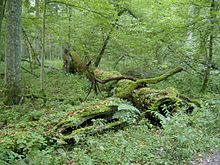
Coarse woody debris (CWD) or coarse woody habitat (CWH) refers to fallen dead trees and the remains of large branches on the ground in forests[1] and in rivers or wetlands.[2] A dead standing tree – known as a snag – provides many of the same functions as coarse woody debris. The minimum size required for woody debris to be defined as "coarse" varies by author, ranging from 2.5–20 cm (1–8 in) in diameter.[3]
Since the 1970s, forest managers worldwide have considered it best environmental practice to allow dead trees and woody debris to remain in woodlands, recycling nutrients trapped in the wood and providing food and habitat for a wide range of organisms, thereby improving biodiversity. The amount of coarse woody debris is an important criterion for the evaluation and restoration of temperate deciduous forest.[1] Coarse woody debris is also important in wetlands, particularly in deltas where woody debris accumulates.[2]
- ^ a b Keddy, P.A.; Drummond, C.G. (1996). "Ecological properties for the evaluation, management, and restoration of temperate deciduous forest ecosystems". Ecological Applications. 6 (3): 748–762. Bibcode:1996EcoAp...6..748K. doi:10.2307/2269480. JSTOR 2269480.
- ^ a b Keddy, P.A. 2010. Wetland Ecology: Principles and Conservation (2nd edition). Cambridge University Press, Cambridge, UK. 497 p, p. 225-227.
- ^ Lofroth, Eric (1998), "The dead wood cycle", in Voller, J.; Harrison, S. (eds.), Conservation biology principles for forested landscapes, Vancouver, B.C.: UBC Press, pp. 185–214, archived from the original on 2008-05-01, retrieved 2007-12-06
